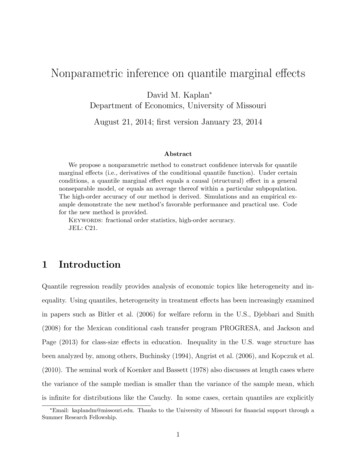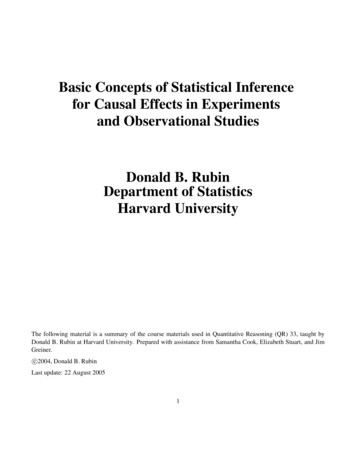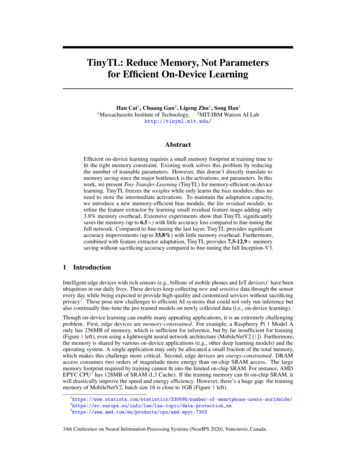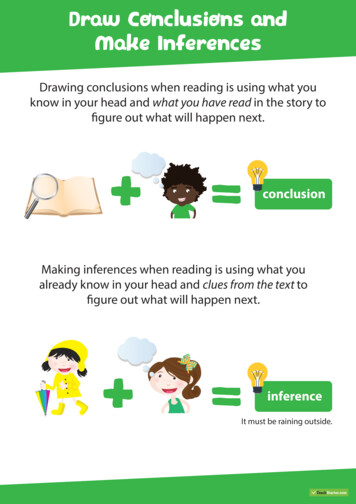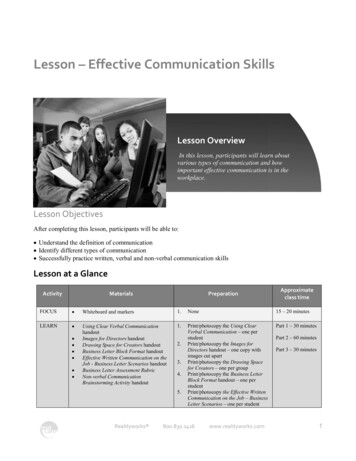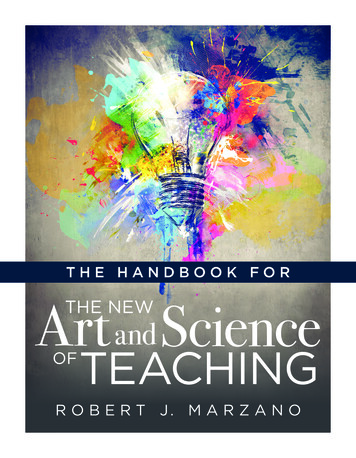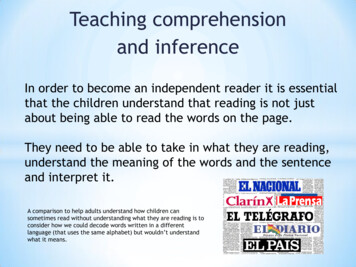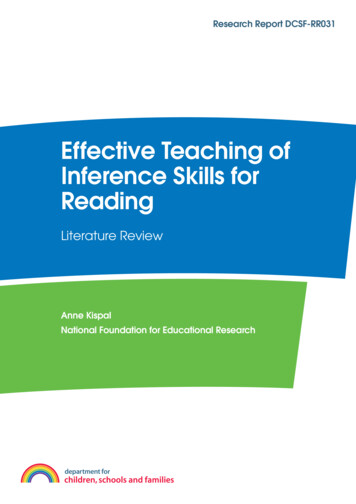
Transcription
Research Report DCSF-RR031Effective Teaching ofInference Skills forReadingLiterature ReviewAnne KispalNational Foundation for Educational Research
Research Report NoDCSF-RR031Effective Teaching of Inference Skills forReadingLiterature ReviewAnne KispalNational Foundation for Educational ResearchThe views expressed in this report are the authors’ and do not necessarily reflect those of theDepartment for Children, Schools and Families. National Foundation for Educational Research 2008ISBN 978 1 84775 141 6
Project TeamAnne KispalResearchersLiz TwistPauline BenefieldLibraryLynne HarrisAlison JonesNikki KeoghProject Administration Assistant
ContentsExecutive summary .21.Introduction .62.Are there different skills in inference?.82.1. Different types of inferences: What are inferences used for? .82.2. Different types of inferences: How many inferences are there?.112.3. What are the skills involved in inference? .122.4. Conclusion .212.5. Summary .223.How can pupils best be taught to use inference skills.243.1. An inference training success story .243.2. What to teach.263.3. Summary .384. What strategies are most effective in teaching inference anddeduction skills to pupils at different ages and abilities.404.1. Materials .404.2. Strategies for children of all ages.434.3. Age-specific strategies: what progression in inference looks like and howit can be supported .454.4. Summary .475.References .48Appendix 1: Search Strategy .581
Executive summaryIntroductionIn 2007, the Department for Children, Schools and Families (DCSF) commissionedthe National Foundation for Educational Research (NFER) to conduct a review ofresearch evidence on inference skills for reading, including the skills that constituteinferencing and how to teach them.BackgroundThe ability to make inferences is, in simple terms, the ability to use two or morepieces of information from a text in order to arrive at a third piece of information thatis implicit. Inference can be as simple as associating the pronoun ‘he’ with apreviously mentioned male person. Or, it can be as complex as understanding asubtle implicit message, conveyed through the choice of particular vocabulary by thewriter and drawing on the reader’s own background knowledge. Inferencing skills areimportant for reading comprehension, and also more widely in the area of literarycriticism and other approaches to studying texts. The National Curriculum lays muchemphasis on the skills of inference, especially at Key Stages 2 and 3.FindingsA key finding of the review was that the ability to draw inferences predeterminesreading skills: that is, poor inferencing causes poor comprehension and not viceversa.Are there different skills within inference?Different researchers have identified many different kinds of inference; however,there is no general consensus in the literature about the number of types ofinference, or how they should be named.The most frequently cited inference types have been defined and exemplified below.It should be noted that there is some overlap between these categories.Coherence inferences (also known as text-connecting or intersentenceinferences). These maintain textual integrity. For example, in the sentence Peterbegged his mother to let him go to the party, the reader would have to realise that thepronouns ‘his’ and ‘him’ refer to Peter to fully understand the meaning.Elaborative inferences (also known as gap-filling inferences). These enrich themental representation of the text, e.g: Katy dropped the vase. She ran for thedustpan and brush to sweep up the pieces. The reader would have to draw upon lifeexperience and general knowledge to realise that the vase broke to supply theconnection between these sentences.2
Local inferences. These create a coherent representation at the local level ofsentences and paragraphs. This class of inferences includes:1. coherence inferences (described above).2. “case structure role assignments”, e.g. Dan stood his bike against the tree. Thereader needs to realise that the tree is assigned to a location role.3. some “antecedent causal” inferences, e.g. He rushed off, leaving his bikeunchained. The reader would need to infer that Dan was in a hurry and left hisbicycle vulnerable to theft.Global inferences. These create a coherent representation covering the whole text.The reader needs to infer overarching ideas about the theme, main point or moral ofa text by drawing on local pieces of information.On-line inferences: inferences drawn automatically during reading.Off-line inferences: inferences drawn strategically after reading.How can pupils best be taught to use inference skills?The research evidence reviewed suggested that, in order to be good at inferencing,pupils need to: be an active reader who wants to make sense of the textmonitor comprehension and repair misunderstandingshave a rich vocabularyhave a competent working memoryInferencing skills are also facilitated by: having a wide background knowledgesharing the same cultural background as that assumed by the textSome of these factors are more pertinent to certain types of inference than others.For example, having a wide background knowledge does not influence the ability todraw coherence inferences to the same degree as it does elaborative or globalinferences.Although the characteristics of good inferencers have been identified, there is limitedresearch evidence to suggest how teachers could best improve the inferencingabilities of their pupils. Available research evidence points to the importance of:Teacher modelling of inferencing: teachers "thinking aloud" their thoughts as they read aloud to pupilsteachers asking themselves questions that show how they monitor their owncomprehensionteachers making explicit the thinking processes that result in drawing aninference.3
Word level work: developing fluent basic reading skills (e.g. practice in decoding print)vocabulary building: aurally and in readinglexical training, e.g. in local cohesive devices (such as pronouns andconnectives).Text level work: making explicit the structure of storiesdiscussing the role and usefulness of a titleemphasising that fiction allows multiple interpretations and inference making.Questioning by the teacher: asking ‘How do you know?’ whenever an inference is generated in discussionof a textasking questions about relationships between characters, goals andmotivationsasking questions that foster comprehension monitoring, such as Is thereinformation that doesn’t agree with what I already know?ensuring that pupils are not interrupted in their reading by asking questionsduring reading time, or launching into questioning too soon afterwards.Questioning by pupils: training pupils to ask themselves Why-questions while readingteaching the meaning of the question words ‘who’, ‘when’, ‘ why’ etc.asking pupils to generate their own questions from a text using these questionwords.Activation of prior knowledge: asking pupils to generate associations around a topic, and discuss and clarifytheir collective knowledge.Prediction and contextualisation: working on predictive and contextualising skills for example via cloze andsimilar exercises.Aural work: listening to stories and story tapeslistening comprehension activitiespractising inferential questions on aurally presented texts.Choosing the right texts: taking care not to choose texts that are too easy for classwork: very explicittexts provide few opportunities for inferences to be made.4
Cross curricular work: discussion of texts in curricular areas outside literacy.What strategies are most effective in teaching inference skills to pupils of differentages/abilities? What does progression in inference look like and how can it besupported?No evidence which directly answers these questions was identified.On the subject of pupils' age, it was apparent that inference can be seen in childrenof all ages and can even be practised with pre-readers using picture books. Thissuggests that inferencing can be practised outside the domain of reading with pupilsof all ages and that one way of cultivating these skills in young readers and reluctantreaders is to do it in discussion, orally.However, at the same time the research indicates that pupils are most receptive toexplicit teaching of inference skills in their early secondary years.Methodology of the reviewThis review was carried out between August and December 2007. The aim was touncover what was known about the teaching of inference by looking through the mostrobust work conducted in the UK over the last 20 years and from the USA over thelast decade. The search was guided by four research questions: Are there different skills within inference?How can pupils best be taught to use inference skills?What strategies are most effective in teaching inference skills to pupils ofdifferent ages/abilities?What does progression in inference look like and how can it be supported?Overall, few studies explicitly investigating best methods for teaching skills wereidentified. The conclusions of this review should therefore be considered as indicativerather than comprehensive.5
1.IntroductionThis work was carried out under contract to the Department for Children, Schoolsand Families (DCSF) in response to a request to review literature on inference anddeduction. From Key Stage 2 onwards, inference is at the centre of the readingcurriculum. Skills of inference are needed not just to be able to ‘read between thelines,’ to detect the unspoken hidden meanings that enrich overall understanding of atext or to draw one’s own personal conclusions about a text. They are needed for allthe other tasks that teachers want their children to do in handling texts: to understandthe effects achieved through choices in vocabulary, to recognise what the writer istrying to accomplish through the whole text and to appreciate what the impact on thereader may be. Almost any reading activity that goes beyond literal understandinginvolves some degree of inference.The research questions guiding the review were: Are there different skills within inference and deduction? How can pupils best be taught to use inference and deduction skills? What strategies are most effective in teaching inference and deductionskills to pupils of different ages / abilities? What does progression in inference and deduction look like and how canit be supported?The evidence baseThe search was targeted at British research dating from 1988 and internationalliterature published in the English language from 1999. The aim was to seek outinformation relating primarily to pupils in Key Stages 2 and 3. As a result of thesearches conducted by the methods described in Appendix 1, roughly one hundredpublications were identified as relevant to the investigation. Upon inspection, 41 ofthese were read and reviewed. The aim was to read both the seminal works, whichtended to date from the 1980s and early 1990s, and recent publications to trace theevolution of thinking in the area and to determine the current ‘state-of-play’.Most of the literature published has tended to be quite narrow in scope in comparisonto that of the two major players: Graesser et al. and McKoon and Ratcliff. Of all thepublications reviewed, Graesser et al. (1994) produced the most in-depth andcomprehensive discussion of inference. Although it should be stated that they werenot particularly focused on pedagogy, nonetheless, teaching implications emergedfrom their work. Of all the literature, this appears to be the most frequently citedpublication. Subsequently, researchers have conducted smaller-scale investigations,often looking at a single narrow aspect of inference. Gygax (2004), for example,examined readers’ inferences of characters’ emotions in narrative texts. Van denBroek (2001) was interested in the most opportune moment for asking pupilsinferential questions during and after reading. Over the past 30 years, Cain, Oakhill6
and Yuill have reported on various very small-scale studies they conducted (often onno more than one classful of children) testing various hypotheses on inference orcomprehension. It is interesting to note that the authors (McGee and Johnson, 2003)of the only recent school-based trial of an inference training intervention referredexclusively to literature published in the 1980s in their bibliography. This leads to theimpression that not much direct testing of inference training has been carried out.More recently, there has been a renewed interest in the link between reading andaural work and in the relation between inference in reading and inference in listening.In order to cover the divergent nature of the research questions (with the first onebeing very abstract in content, while the remaining three are practical) the reviewedmaterial tended to fall into three provinces: PsychologyPedagogy on comprehension instructionSmall scale research into aspects of inference instructionAs so few studies into inference teaching were identified, some publications wereretained and reviewed although they did not meet the strictest of the selectioncriteria. These had other merits that supported their inclusion. As a result of thedecision to limit the review to English language publications, the European traditionof thought on these questions has been largely omitted.The remit, therefore, was to review all that is known about inference and deduction.Those who are involved in the field of teaching reading and who are familiar with theNational Curriculum and the Literacy Strategy talk almost daily of ‘inference anddeduction.’ They are always mentioned in tandem, as a seemingly inseparable pair ofskills. However, one of the first things to strike the researcher is that neither thenational nor international research literature ever speak of deduction. All thediscussion and investigation in this area refer exclusively to inference. The mostrecently published National Primary Strategy document ‘Developing ReadingComprehension’ (DfES 2006), which devotes a sizeable section to inferential skills,also fails to mention deduction. Even amongst researchers who have distinguished asurprisingly large number of different types of inference classes, deduction does notfeature in their lists. If asked, experts can offer plausible definitions which distinguishbetween the two (deduction generally interpreted as somewhat narrower thaninference) but deduction does not appear to be the subject of much academicinvestigation or discussion. This would suggest there is no useful distinction in thecognitive processes that underlie the two and this report will therefore follow theestablished tradition by referring only to inference.7
2.Are there different skills in inference?2.1. Different types of inferences: What are inferences used for?Whether experimental or review in purpose, most studies have laid out meticulouslydetailed analyses of the types of inference that exist in their authors’ view ofcomprehension. The literature has been prolific in distinguishing various types andcategories of inference, ranging from thirteen, described in Graesser et al. (1994),nine in Pressley and Afflerbach (1995), to the more usual two, adopted by manymore researchers. Even amongst those experts who have identified essentially thesame single distinction between two types of inference, there is an assortment oflabelling. Commenting on this variety in the naming of inferences, Graesser et al.(1994) concluded researchers in psycholinguistics and discourse processing haveproposed several taxonomies of inferences [cites eight publications] but a consensushas hardly emerged, (p. 374).A suitable starting point is perhaps the work of the British researchers, Cain, Oakhilland Yuill, aided over the years by numerous colleagues, who have been studyingvarious aspects of comprehension since the 1980s. Their distinction (Cain andOakhill, 1999) was between text-connecting or intersentence inferences and gapfilling inferences. The difference they specified was that intersentence / textconnecting inferences are necessary to establish cohesion between sentences andinvolve integration of textual information. Gap-filling inferences, by contrast, makeuse of information from outside the text, from the reader’s existing backgroundknowledge. Interestingly, in a more recent study published in 2001, these authors(like Barnes et al.,1996; Calvo, 2004; Bowyer-Crane and Snowling, 2005 and DfES,2006) adopted the more current terms of coherence versus elaborative inferencing,which roughly equate to text-connecting and gap-filling respectively. Coherenceinferences maintain a coherent text and involve adding unstated but importantinformation such as causal links, e.g. The rain kept Tom indoors all afternoon. In thissentence, the reader understands that Tom wanted to go out but that the unpleasantweather conditions prevented this. They are seen being essential to constructingmeaning, and as a result, only minimally affected by knowledge accessibility becausecognitive activity will keep going until the necessary information to make theinference is found. Elaborative inferences embellish and amplify. As unnecessary toachieve comprehension, these inferences will be influenced by accessibility ofknowledge.Bowyer-Crane and Snowling (2005) have also espoused the current terminology ofcoherence versus elaborative inferencing in their analysis of inferential questionsused in reading tests. They extended and refined the distinctions by addingknowledge-based and evaluative. The particular feature of the two additionalinference types was that although they depend on the application of life experienceand outside knowledge (like elaborative inferences) they were still deemed essentialto the understanding of text. Knowledge-based inferences rely on the activation of a‘mediating idea’ from the reader’s own world-knowledge, without which the text is8
disjointed. Evaluative inferences relate to the emotional outcome of the text, such asthe emotional consequences of actions in a story. It is worth restating that theauthors view knowledge-based and evaluative inferences as not optional tounderstanding and maintain that these inferences have to be drawn in order toachieve comprehension.It is interesting to note that in one of the most recently published articles in this field,Cromley and Azevedo (2007) use none of the terms outlined above but refer insteadto text-to-text and background-to-text inferencing which equate to the coherence ortext-connecting and elaborative or gap-filling distinctions described above. Inaddition, they specify anaphoric inference as a separate category on its own.Previous researchers had assigned this type of inference to coherence or textconnecting as it generally involves cross-referencing between synonyms or betweenpronouns and their referents.In other studies, the dividing line has been defined in different terms. There is, forexample, the difference between local and global (Graesser et al., 1994; Beishuizenet al., 1999; Gygax et al., 2004) Local inferences create a coherent representation atthe local level of sentences and paragraphs while global covers the whole text.Graesser et al. (1994) necessitate special attention because of their comprehensivediscussion of inference on many levels. The difference between the work of theseresearchers and others is that they identified several ways of categorising groups ofinference types whereas others tended to focus on a distinction on one dimensionbetween usually (though not necessarily) two types. The categories they recognisedincluded both text-connecting / knowledge-based and local / global. They were,however, primarily interested in the on-line / off-line distinction, in determining whichinferences are carried out automatically during reading (on-line) and which only ariseif prompted (off-line). In the course of their work, they discriminated and coined 13different forms of inference, which are listed in Table 2.Interestingly Singer, who was one of the contributors to the comprehensive taxonomyin Graesser et al. (1994), also used the term bridging inference (Singer et al., 1992,Singer et al., 1997). This term does not feature in the Graesser et al. taxonomy,despite its thoroughness, and adds further evidence of the lack of consensus.Bridging inferences are cited in the Primary National Strategy document ‘DevelopingReading Comprehension’ (DfES, 2006) as being a common way of referring tocoherence-preserving inferences.9
Table 1 lists the most frequently cited distinctions between different types ofinference, while Table 2 overleaf lists the different inferences themselves.Table 1 - Distinction between Different Types of InferencesAuthorDistinctions identifiedMcKoon andRatcliff, 1992automaticstrategicGraesser etal.,1994Long et al.,1996on-lineoff-lineGraesser etal.,1994Graesser etal.,1994Beishuizen et al.,1999Gygax et al., 2004text-connectingknowledge-based or extratextuallocalglobalBarnes et al., 1996Calvo, 2004coherenceelaborativePressley andAfflerbach, 1995(unconscious)consciousSinger et al., 1997bridgingCain and Oakhill,1998intersentence or text- gap-fillingconnectingBowyer-Crane andSnowling, 2005coherenceCromley andAzevedo dbackground-to-textevaluative
2.2. Different types of inferences: How many inferences are there?While most of the work conducted focuses on distinctions between two or three typesof inference, two studies - Graesser et al. (1994) and Pressley and Afflerbach (1995)- stand out because of their detailed and thorough cataloguing of as many inferencesas they were able to find. Table 2 below presents a summarised version of their lists.It should be added that due to their method of data collection, i.e. use of the thinkaloud protocol, Pressley and Afflerbach described their list of inferences as those ofwhich readers were consciously aware and which they were able to describe in theirown words. As ‘think-aloud’ methodology involves questioning subjects duringreading about the cognitive processes that they are carrying out, the implication isthat there may be other inferences which readers carry out subconsciously and whichare not therefore included in their list.Table 2 - InferencesGraesser, Singer, Trabasso1. referential2. case structure role assignment3. antecedent causal4. superordinate goal5. thematic6. character emotion7. causal consequence8. instantiation noun category9. instrument10. subordinate goal action11. state12. reader’s emotion13. author’s intentPressley and Afflerbach1. referential2. filling in deleted information3. inferring meanings of words4. inferring connotations of words /sentences5. relating text to prior knowledge (furtherdivided into 12 sub-types)6. inferences about the author (5 types)7. characters or state of world asdepicted in text (6 types)8. confirming / disconfirming previousinferences9. drawing conclusionThere is some overlap in the two lists, such as inferencing about characters andabout the author but the two lists reflect different ways of looking at inference.Graesser et al. (1994) emphasise the focus of the inference (character, theme,instrument), whereas Pressley’s list catalogues the processes (confirming,concluding, relating).Despite the lack of unanimity about the range of inferences, how to refer to andcategorise them, there is only one aspect that has excited a public disagreement. Byno stretch of the imagination could this be termed a fiercely raging debate, but it doesremain a source of contention. The divergence of opinion lies principally betweenthose who ally themselves with Graesser et al. representing the ‘constructionist’ viewand those that follow the ‘minimalist’ theory of McKoon and Ratcliff (1992). Theconstructionist theory assumes that the reader is engaged in a constant ‘search11
(effort) after meaning’ to build a situation model of the text that is coherent both atlocal and global level and will draw all the inferences needed to explain why thingsare mentioned in the text in order to achieve coherence. The minimalist view is ‘thatthere is only a minimal automatic processing of inferences during reading readersdo not automatically construct inferences to fully represent the situation described bythe text’ (McKoon and Ratcliff, 1992, p. 440). According to this model, inferences thatare not required to establish local coherence (i.e. elaborative inferences) areencoded only to the extent that they are supported by readily available worldknowledge (Long et al., 1996, p. 192). Long et al.’s own study did not help to settlethe issue but only concluded that good readers carry out more inferences than theless able, as indicated in the closing remark of their article: Our data suggest thathigh-ability readers encode knowledge-based inferences that low-ability readers failto encode only high-ability readers encode topic-related inferences. (p. 210)As the main purpose of this review is to inform pedagogy throughout Key Stages 2and 3, the debate is largely of academic interest. The question is what practical stepscan a teacher take to get all readers to do more of what good readers usually doautomatically and instinctively. Even the inferences that are not usually carried outduring reading are of interest to English teachers, as these are often those that areinvolved in literary criticism and analysis. All inferences are therefore the subject ofthis review - whether or not they are carried out on-line.2.3. What are the skills involved in inference?The first aim of this review was to uncover what is known about the different skills ininference and deduction. One might argue that listing the plethora of inference labelsand classes in sections 1.1 and 1.2 is not especially informative in providing answersto the first research question posed. However, in the absence of much evidence ofthe actual skills that readers need to be good inferencers, this information helps toshed some light on what is involved in an inference. The same is true of the cognitiveprocesses.While there seems to be little written about the inherent abilities and skills involved,the literature is revealing about the processes that are thought to take place in theinstant of inferencing and there has been research and discussion of thepreconditions that permit inferences to happen. This section will therefore reflect theavailable literature by outlining what is known about the cognitive processes and theother factors that influence inferencing.Cognitive processes involved in an inferenceAlthough there is no consensus about which inferences are drawn consciously orsubconsciously, automatically or strategically, the following section will demonstratethat various experts appear to have arrived at similar conclusions about the cognitivesteps involved in an inference.12
What happens in working memory?One of the most comprehensive works conducted in the field was that of Graesser etal. (1994). Not only did the authors identify a large number of inference types (asseen above), they looked at the constituent stages of inferencing and identifiedtriggering processes that fire the production of an inference. Their analogy, in whichthey equate inferencing to the solving of a mental syllogism, was based on Singer’smodel (Singer et al., 1992) and is frequently reflected in the literature. They proposedthat the reader constructs a mental syllogism, from two available premises in the text,but with a third missing. The reader solves the syllogism by supplying the missingpremise (a ‘mediating idea’), which is the inference. In supplying the missingpremise, the reader:1.2.3.4.searches for information in the long term memory and the working memorysearches in other places (perhaps looking further back in the text)brings the content of the working memory back into play (ie reactivates thetwo premises that originally prompted the searches in 1 and 2)checks that the inference adequately explains and agrees with the twopremises held in the working memory.In the work of Graesser et al. it is the importance of the capacity of the workingmemory that becomes apparent and is taken up again and again by otherresearchers. In their constructionist interpretation of reading, the authors believe thatsuch is the need of readers to make sense of a text that they will even keepunsatisfactory explanations / inferences in play, until a more plausible explanationcomes along.With text-connecting inferences, the current clause is related to a previous explicitstatement, which is then re-instated or re-activated and inferentially linked to thecurrent clause. In the case of knowledge-based inferences,
important for reading comprehension, and also more widely in the area of literary criticism and other approaches to studying texts. The National Curriculum lays much emphasis on the skills of inference, especially at Key Stages 2 and 3. Findings A key finding of the rev
